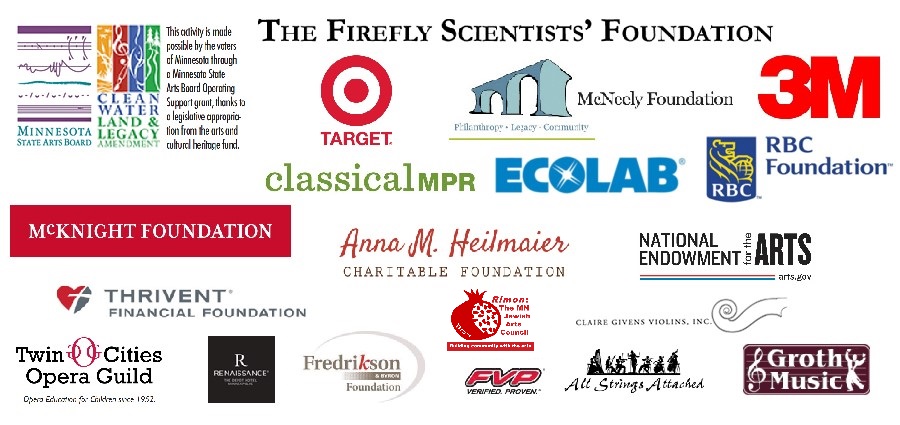Please click here for COVID-related updates
Inna Faliks, Piano
Inna Faliks, Piano
Fri. Feb 17 Roseville Lutheran Church 7pm
1215 Roselawn Avenue W., Roseville, 55113
Sun. Feb 19 Basilica of St. Mary 2pm
1600 Hennepin Avenue, Minneapolis, 55403
Program
ContemplationJay Fishman
Premiere performances
Piano concerto in d minor, K. 466Wolfgang Amadeus Mozart
Inna Faliks, piano
NovellettenSamuel Coleridge-Taylor
Fantasia on a theme of Thomas TallisRalph Vaughan Williams
Program Notes
ContemplationJay Fishman (b. 1947)
In mid-March of 2020, the negative repercussions from COVID 19 were increasing day by day, and of course were taking a horrific toll on the health and well-being of the community. These effects certainly affected the Sinfonia, and we cancelled the rest of the winter season, the entire summer season, and I recognized that the upcoming fall season probably was in doubt. Always the optimist, I started creating activities for our musicians to undertake during the time that we were not going to play as a full orchestra, and planning for the eventual re-start of live performing. I divided my energies into creating alternate programs for our musicians (instructional and chamber music videos), researching, arranging music by Black and Latino classical and romantic composers, and composing.
Composing became a much-needed creative outlet. The pandemic certainly was taking an emotional toll on me, and I was curious how it would affect my composing. When I started what was to become the first movement of Braving the Unknown, I did not have any ideas of how to begin and what to say. And at that time, I certainly did not have this title in mind. I started “musical doodling” – writing out ideas and motives – and then seeing if any of them could amount to something interesting. I eventually came up with a jagged line that would become the initial driving motif. Once the line was decided, it led to a couple of variations, followed by a rather dramatic and pounding section – almost like a cry for help or anguish. Interestingly, I did not intend a melodramatic moment, but it just sort of happened. Eventually, I felt that the piece needed some relief, so a slower and more somber section followed, but it still has a sense of anxiety. Next came a series of waltzes, but again with that sense of angst.
The second movement, which is played on this set of concerts, also has a sense of unease. I called it Contemplation, with the idea that trying to make sense of all that was happening was very difficult and unnerving. Even with melodic lines throughout, I included many dissonances, which are meant to be jarring. And again, there are loud cries of despair. In the middle section there is a playful section, but even it has a few questionable moments. The ending brings back memories of the beginning, and the piece ends with a question mark. I soon realized that when all is said and done, the pandemic did affect my work, including my composing. I have dedicated this music to the memory of a dear friend and colleague, Kathy Hardy, who worked with the Sinfonia for fourteen years as part of our Music in the Schools. jf
Piano concerto in d minor, K. 466Wolfgang Amadeus Mozart (1756-1791)
In 1871, Mozart asked to be relieved of his duties as the court musician in Salzburg so that he could move to Vienna, where he was in much demand as a composer, performer and teacher. His popularity was so great, and he had such acclaim, that in 1784 he composed five piano concertos along with a great deal of chamber music. Between 1784 and 1786, among many other works, he composed a total of twelve piano concertos that he and his students performed.
The piano concerto K. 466 performed on this set of concerts was composed in 1785. It was one of only two concertos that was written in a minor key. Perhaps because of the brooding nature of the key, it remained in the popular contemporary repertoire longer than Mozart’s other concertos. It was a favorite of Beethoven, Brahms, Hummel, Clara Schumann and other famous pianists and composers, who all played it at their concerts. Now, of course, nearly all of Mozart’s twenty-seven concertos are performed regularly all over the world.
In a letter to Mozart’s sister, his father Leopold observed that
…the concerto was incomparable, the orchestra excellent.
But he also wrote that
the copyist was still working when we arrived, and your brother did not even have time to play the rondo [the last movement] through, as he had to [supervise] the copying.
Not only did Leopold note that his son had waited until the last minute to finish the piece, but implied that perhaps this was not so unusual. In fact, there are stories that several of his solo concerto parts and other chamber music piano accompaniments were not ready for the performances, so Mozart simply “ad libed” during the performances. There is not much more to say after this. jf
NovellettenSamuel Coleridge-Taylor (1875-1912)
Samuel Coleridge-Taylor was born in London, England, the son of Daniel Peter Hughes Taylor, who was a black doctor training at Taunton and King’s College, and an English white mother, Alice Martin. Because of his color, his father was not allowed to practice medicine in England. Consequently, he returned to his home country of Sierra Lerone not knowing of Samuel’s birth. Alice Martin stayed in England and named her son Samuel after the famous Samuel Taylor Coleridge.
Early on, Samuel’s musical skills were recognized, and by age fifteen he was able to study at the Royal College of Music. In 1898, at the behest of England’s most prominent composer, Edward Elgar, he was awarded a commission to write a work for the Gloucester Festival. The resulting Ballade in a minor was very successful and helped to establish his reputation. During the next two years, he composed a trilogy for soloists, chorus and orchestra based on the story of Hiawatha. After seeing the first performance of Hiawatha’s Wedding Feast, the principal of the Royal Academy of Music proclaimed the work to be “one of the most remarkable events in modern English musical history.” Not to be outdone, Elgar wrote that Samuel was “far and away the cleverest fellow amongst the young men.”
In 1873, the Fisk Jubilee singers toured England and exposed the English public to Black American spirituals. Samuel eventually heard some of the music, became fascinated, and began incorporating African American folk songs into his works. He was very proud of his African roots, and in 1896, after meeting the African American poet Paul Laurence Dunbar, began collaborating, with Samuel setting some of Dunbar’s poems to music. Joint recitals quickly followed. In 1900, Samuel was chosen to be one of thirty-seven delegates to the first Pan-African Conference in London, where he gave the opening address. Because of these ties, African Americans became enthralled with Samuel’s music, not only forming a Samuel Coleridge-Taylor society, but also sponsoring three successful American tours. While in America, he conducted the Marine Band and the Coleridge-Taylor Society chorus, and met Booker T. Washington and President Theodore Roosevelt. Samuel continually incorporated Black music and folk songs into his work. Some examples include the African Suite, African Romances and Twenty-four Negro Melodies.
Returning to England, Samuel continued composing, taught at Trinity College of Music, and conducted several choral societies (including the Handel Society) from 1904 until his death in 1912.
Samuel Coleridge-Taylor was a very important and respected musician who had become a significant part of the English cultural establishment. To emphasize the point, King George V donated money for his funeral and gave his wife a monthly pension of 100 pounds for the rest of her life. The inscription on Samuel’s tombstone, taken from the story of Hiawatha which brought him so much fame, also summed up his life:
Too young to die, his great simplicity, his happy courage in an alien world, his gentleness made all that knew him, love him.
The two Novelletten heard in these performances are part of a larger suite of four pieces, all composed for string orchestra. Like so many of Coleridge-Taylor’s works, they are simply meant to be fun to play and fun to listen to. I think the composer succeeded on both accounts. jf
Fantasia on a theme of Thomas TallisRalph Vaughan Williams (1872-1958)
Ralph Vaughan Williams was one of the giants of twentieth century English music. His writing for strings (violins, violas, celli and basses), is among the very best, and helped to create the British school and approach to string writing. His exceptional use of the different tone colors of the strings, his seamless merging of phrases, and his seemingly effortless connecting of the instrumental groups has made him a model for the generations that followed.
The Fantasia on a Theme of Thomas Tallis is one of Vaughan Williams most famous and popular works. The music was composed for two string orchestras and a solo string quartet. The second orchestra is meant to be a small ensemble, and the quartet is part of the larger first orchestra. This piece works in both large and small orchestra settings. With the larger forces, the Fantasia’s lush beauty and lyricism tend to dominate. When performed with the smaller orchestra, the very subtle rhythmic changes become more apparent. Regardless of the size of the orchestra, the listener is treated to a great piece of music, and one that makes a lasting impression. jf

